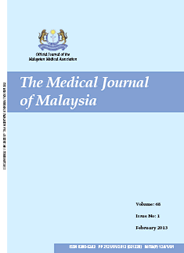MJM, Vol 70 Supplement 1 September 2015
Determinants of sick leave duration and return to
work post-acute coronary syndrome among employees in Kelantan
*Department of Community Medicine, Universiti Sains Malaysia, **Unit of Biostatistics and Research Methodology, Universiti Sains Malaysia, ***Department of Medicine, Universiti Sains Malaysia, ****Department of Medicine, Hospital Raja Perempuan Zainab II, Kelantan
ABSTRACT
Introduction: Acute Coronary Syndrome (ACS) is the number one cause of death in the world and the third cause of death in Malaysia. Information on sick leave duration and return to work among employees diagnosed with first episode of ACS was limited. The aims of the study was to determine the predictive factors for sick leave duration, and factors associated with return to work three months post ACS among employees diagnosed with first episode of ACS in Kelantan.
Methods: Prospective cohort study design was used. The study populations was employees who were working in Kelantan and admitted into cardiology centre in two public hospitals in Kelantan that fulfilled the study criteria. The duration of study was 15 months. Proforma was used for data collection. The respondents was follow up for three months. Multiple linear regression analysis was used to determine the predictive factors for sick leave duration and multiple logistic regression analysis was used to determine the factors associated with return to work three months post ACS.
Results: A total of 78 respondents participated in this study. The predictive factors for sick leave duration were smoking (adjusted β=20.13, 95%CI: 10.36, 39.24 and p value= 0.001), not attending cardiac rehabilitation after discharge (adjusted β=19.94 days, 95%CI: 6.86, 33.61 and p value= 0.005) and complication during admission (adjusted β=28.57, 95%CI: 15.11, 42.03 and p value <0.001). The sick leave duration was associated with return to work (adjusted OR=0.96, 95%CI: 0.92, 1.00 and p value= 0.033).
Conclusion: Being a smoker, had complication during hospital admission and not attending cardiac rehabilitation after discharged from hospital had increased the sick leave duration. Furthermore, sick leave duration had delayed employees with first episode of ACS return to work three months post ACS.
Keywords: Acute Coronary Syndrome, Sick Leave duration, Return to Work, Employees
